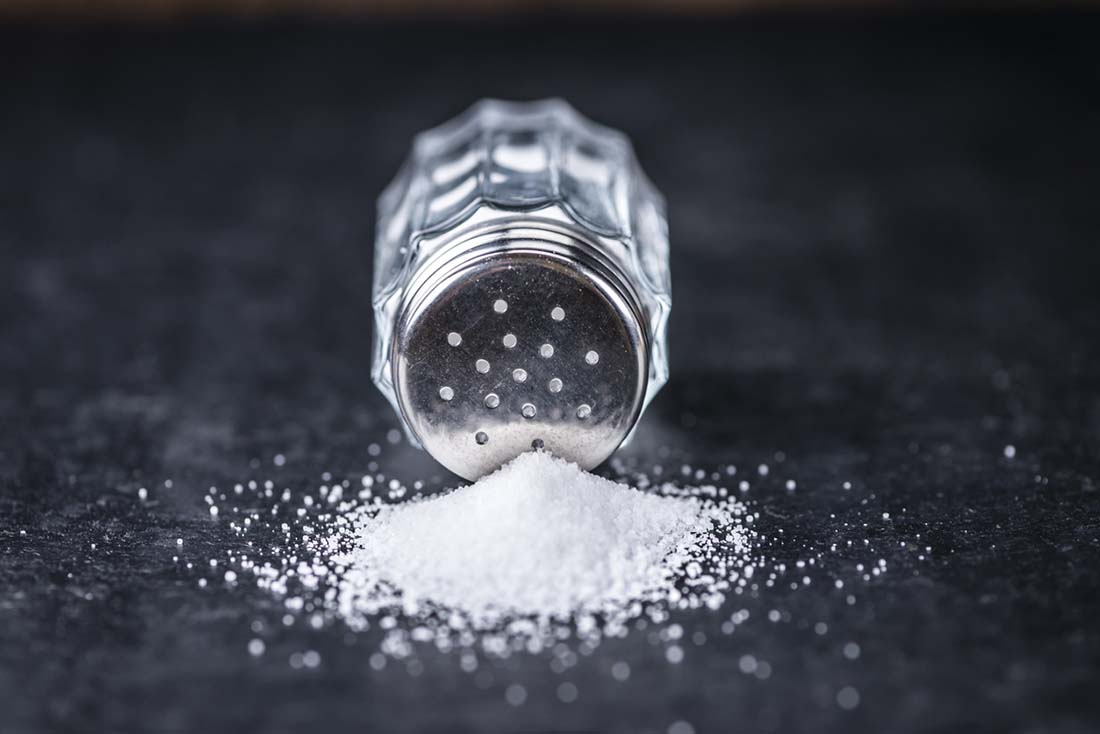Is Salt Bad For Dogs?
Salt, also known as sodium chloride, is an essential part of your dog’s diet, just like it is an essential part of your diet. But, just as is true for human foods, large amounts of salt can cause problems.
Salt, also known as sodium chloride, is an essential part of your dog’s diet, just like it is an essential part of your diet. But, just as is true for human foods, large amounts of salt can cause problems.
Let’s take a closer look at what amount of salt is good for dogs and what kinds of problems high salt levels, something known as hypernatremia, can cause.
Why Do Dogs Need Salt in Their Diet?
Dogs, like humans and other animals, need a minimum level of salt intake to help regulate the fluids in their body, which is vital for the function of their kidneys, heart, and liver, among other organs.
Salt is an electrolyte that is also important for the contraction of muscles and the proper conduction of nerve impulses. Low sodium levels can cause a host of problems, including worsening problems associated with heart disease and upsetting the body’s fluid balance.
Salt is also important for helping prevent low blood pressure (even though an excessive amount of salt is associated with high blood pressure in humans, this has yet to be demonstrated in dogs or cats). Low sodium levels can also affect brain activity, cause muscle twitches, and result in seizures, a loss of consciousness, and even death.
This is particularly true if sodium levels fall rapidly. That doesn’t tend to happen when there is access to salt, however, as shown in one study where rats deprived of sodium avoided activities they normally enjoyed. Researchers suggest it’s possible that salt is a natural anti-depressant that animals and humans normally crave.
It’s clear, therefore, that salt is a necessary component of a healthy diet, but how much salt does a dog’s body need, and what happens if he gets too much?
How Much Salt Does Your Dog Need?
The Association of American Feed Control Officials (AAFCO) recommends a minimum of 0.3% sodium for maintenance and to support growth and development. Most of the time, your dog gets that through a normal diet of dog food without the need to add it to his diet.
Of course, if your dog has certain health conditions, he might need more or less salt, depending on the specific condition. In general, though, he doesn’t need a lot of salt. For that reason, you want to avoid giving him certain salty foods, particularly human foods like pretzels, chips, other salty snacks, or foods that you flavor with table salt.
It’s also important that pet parents take appropriate steps to ensure that their pooch always has plenty of fresh drinking water. This will avoid elevating salt levels in your dog’s body. Not doing so can result in damage to sensitive organs like the kidneys.
What Is Salt Toxicosis?
Hypernatremia is then there is too much salt in your dog’s blood. Normally, the sodium levels in the bloodstream stay in balance if your dog is healthy. But if, for some reason, those levels get too high, the salt will draw more water out of the body’s cells, and into the bloodstream. That can harm the brain and nervous system tissues.
While rare, salt toxicosis can be deadly. Moreover, salt toxicity isn’t something that builds up slowly over time. Rather, it happens in a single ingestion over a short period of time. That means it can happen very quickly, but how does it happen?
There are several possible ways that a dog can experience hypernatremia. Some of which you might not even be aware of, such as by ingesting certain de-icers like rock salt. If you live in a cold part of the country and use rock salt to de-ice your sidewalk, it’s possible your dog could ingest it that way.
What’s more, if your dog gets into antifreeze, it contains salt and can result in salt poisoning. Antifreeze is sweet tasting and attractive to pets of all kinds and even small children, so take care when changing your car’s radiator fluids.
Believe it or not, consuming homemade play dough or salt dough is another possible cause of salt toxicity. Even ingesting paintballs, which can happen in a single swallow, can cause hypernatremia.
As mentioned before, if your dog doesn’t have enough fresh water, the salt levels in his blood can rise. Another possible cause of salt poisoning is enema solutions (I know, right?). If your dog gets into one of those, they contain sodium, and he can get too much that way.
Of course, your dog can also get too much salt simply by consuming table salt or other salty foods, like soy sauce. Remember, it only takes a single ingestion of a high amount of sodium to result in toxicity. The situation can get even worse if your dog doesn’t have access to fresh water.
Symptoms of Salt Poisoning
The danger presented by salt poisoning depends, in part, on your dog’s size. Smaller breeds are at a higher risk, as you might imagine. According to the American College of Veterinary Pharmacists, it takes as little as two to three grams of sodium chloride for each kilogram of body weight to cause poisoning.
That means that if a small dog eats as little as a teaspoon, he could become sick from toxicity. A large dog, like a Great Dane, would have to eat more than four tablespoons to experience toxicosis.
In either case, the symptoms of salt poisoning include:
- vomiting
- diarrhea
- loss of appetite
- lethargy
- excessive thirst or urination
- lack of coordination
- tremors or seizures
If you see these signs of salt poisoning in your dog, it’s important to get him to the veterinarian immediately for treatment. Normally, your vet will do some bloodwork, and perhaps run an EKG, to determine the cause of the symptoms. If they diagnose salt toxicity, they will likely administer IV fluids as part of the treatment.
Should You Make Sure Your Dog Avoids Salty Foods Altogether?
If you are feeding your dog salt in moderate amounts as a part of their regular food, it’s likely you won’t have a problem. You can even occasionally give him something like a potato chip. The key is to give those kinds of salty foods in moderation.
As always, it’s also important to ensure that your dog has access to plenty of fresh water. And if you take your dog to the beach regularly, don’t let him drink excess amounts of salt water.
Of course, if your dog has a health condition, you want to closely monitor any salt he receives. You don’t want to stop providing salt altogether, but use common sense and always provide fresh water.
Video: A Veterinary Toxicologist’s Take on Salt
Dr. John Tegzes, VMD, Diplomat American Board of Veterinary Toxicology from Western University of Health Sciences discusses how salt is a nervous system poison and that it can be found in a variety of places in the home.
Watch the full video here:
Feed Whole Foods Without Excess Salt
JustFoodForDogs believes that a balanced diet of whole food ingredients and no preservatives is key to your dog’s health. Our fresh meals are made with whole ingredients and provide human-grade nutrition.
We strive to provide the optimal level of nutrients for all of your dog’s nutritional needs. We even have a line of vet-prescribed food for dogs. We’re confident that if you give us a few weeks, we can change your dog’s life forever. Give our food a try today for a healthier, happier, best friend!
This content is for informational use only and does not replace professional nutrition and/or medical advice, diagnosis, or treatment. It is not a substitute for and should not be relied upon for specific nutrition and/or medical recommendations. Please talk with your veterinarian about any questions or concerns.








